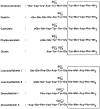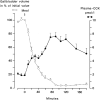Cholecystokinin and the hormone concept
- PMID: 33640870
- PMCID: PMC8052576
- DOI: 10.1530/EC-21-0025
Cholecystokinin and the hormone concept
Abstract
The birth certificate for endocrinology was Bayliss' and Starling's demonstration in 1902 that regulation of bodily functions is not only neuronal but also due to blood-borne messengers. Starling named these messengers hormones. Since then transport via blood has defined hormones. This definition, however, may be too narrow. Thus, today we know that several peptide hormones are not only produced and released to blood from endocrine cells but also released from neurons, myocytes, immune cells, endothelial cells, spermatogenic cells, fat cells, etc. And they are often secreted in cell-specific molecular forms with more or less different spectra of activity. The present review depicts this development with the story about cholecystokinin which was discovered in 1928 as a hormone and still in 1976 was conceived as a single blood-borne peptide. Today's multifaceted picture of cholecystokinin suggests that time may be ripe for expansion of the hormone concept to all messenger molecules, which activate their target cells - irrespective of their road to the target (endocrine, neurocrine, neuronal, paracrine, autocrine, etc.) and irrespective of their kind of activity as classical hormone, growth factor, neurotransmitter, adipokine, cytokine, myokine, or fertility factor.
Keywords: bioactive peptides; cholecystokinin; growth factors; hormone concept; neurotransmitter peptides.
Figures




References
-
- Starling EH.The Croonian Lectures: on the chemical correlation of the functions of the body. Lancet 1905. 2 339–441; 423,–425; 501,–503; 579–583.
-
- Pavlov IP.Beiträge zur Physiologie der Absonderung. Zeitblatt für Physiologie 1888. 2 137–138.
-
- Popielsky LB.Über das periferische reflektorische Nervencentrum Des Pankreas. Pflügers Archiv für Physiologie 1901. 86 215–246.
Publication types
LinkOut - more resources
Full Text Sources
Other Literature Sources

